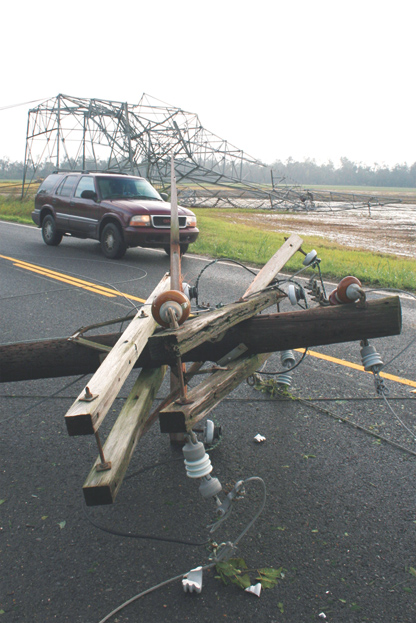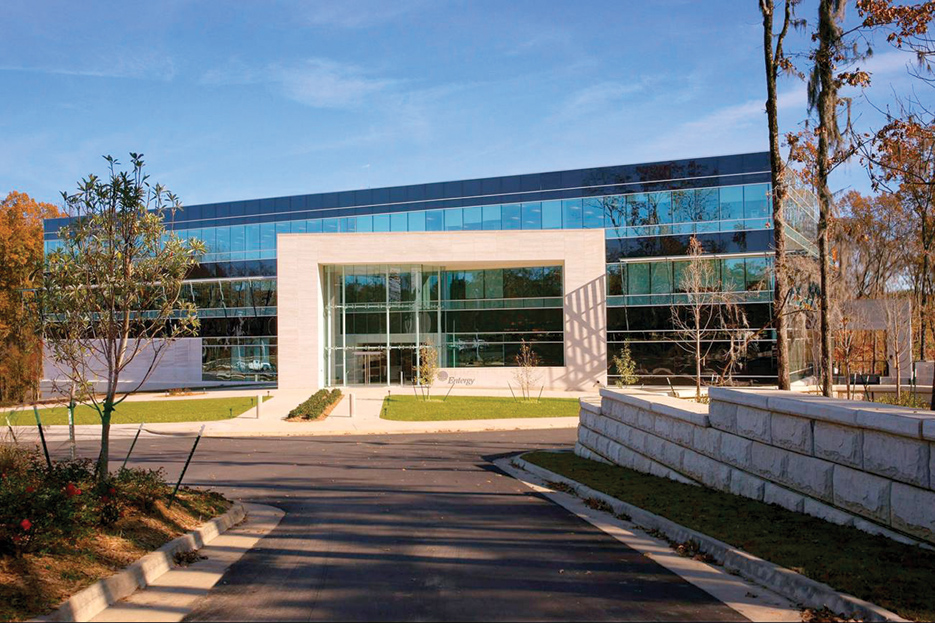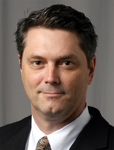Tested by nature and driven by industry change, Entergy Corporation has emerged as one of the leading utility companies in the world. Over the last decade, Entergy reshaped itself from a company with operations scattered around the world to a world-class U.S. utility focused on meeting the needs of its customers while creating value for shareholders. Entergy is now one of the largest electric utilities in the country with 2.7 million retail customers and more than $10 billion in annual revenues. The transformation hasn’t always been easy. During five years of that decade of change, Entergy’s utility companies battled nature’s fiercest forces… and won.

Hurricane Katrina devastated Entergy’s
transmission and distribution networks as
evident in this photo in Plaquemines Parish,
La. taken soon after the storm had passed
through. Lessons learned from that storm and
three others helped shape the company’s
course over the past five years.
The devastation from hurricanes Katrina, Rita, Gustav and Ike affected many of the company’s customers, and the damage done by the storms won’t be forgotten by any of the utility company employees who live and work in Arkansas, Louisiana, Mississippi or Texas. Tackling major disasters takes patience and persistence and requires constant adjustments to changing circumstances, the same skill sets needed to navigate the turbulent operating and regulatory environments of today’s electric power industry.
But the struggle to overcome the destruction produced by these catastrophic events paid long-term dividends for Entergy. The company has used the lessons learned preparing for and rebuilding after each event to shape strategies that reach beyond disaster preparation and recovery disciplines. Indeed, preparing for and responding to the storms did more than sharpen the company’s disaster recovery skills. The logistical planning and coordination involved are now proving their value under routine business conditions.
Turbulent Times; Economic Storms
Over the last decade the electric power industry has changed in major ways. Wholesale power deregulation, national energy legislation, more stringent reliability standards, more demanding operating economics, fuel cost volatility and technology have been the chief change drivers.
Regulatory, legislative and economic forces can profoundly change the wholesale and retail electric power marketplaces, how customers use energy and how industry professionals do their jobs. These changes call for the same urgency of response that customers, the media and government officials call for in the wake of disaster.
Meanwhile, no one in the electric power industry has escaped the impact of national and global economic conditions. Demand in 2009 fell 4 percent below expected levels, in part because of demand response and energy efficiency. However, economic factors drove the largest portion of last year’s demand decline.
The North American Electric Reliability Corporation’s forecast last October brought this home when NERC cut its estimate for annual demand growth in North America to below 1.5 percent. That projected demand growth was down from an earlier projection of almost two percent. NERC’s revised estimate – if it holds true – means demand will reach approximately 4,700 GWh in 2011 instead of this year, as had been previously predicted1.

Entergy employees at a recently built new substation in
Louisiana during final check out prior to energizing.
Entergy’s operating companies have made significant
investments in infrastructure in the wake of four
major hurricanes.
Growth Without Demand Growth
Historically, reduced demand meant less construction of bulk power facilities, but this time that may not be the case. NERC has signaled that more than 11,000 miles of new transmission lines will be needed by 2013, double the average number of transmission miles constructed during the last 20 years. Policymakers believe that nearly 230,000 megawatts of new wind and solar generation would require that much new transmission capacity.
Complicating the issue is that wind and solar technologies cost more than conventional generation. Broad acceptance of the idea of greener energy depends on economic forces. At press time, Louisiana’s retail regulators were studying a non-mandatory renewable portfolio standard. The economic status of the commission’s constituents is a consideration. During times of tight household budgets, the higher price that green energy often demands can outweigh consumer enthusiasm. Moreover, the locations of that wind and solar generation in the southwest and Midwest will require new transmission in those regions to overcome existing constraints so that renewable power can be shipped to other regions. Technically this is feasible. However, the unanswered questions are: What will it take to make that massive investment a sound business decision? Who will pay for and benefit from the new transmission capacity? How will siting and permitting be handled?
Rules of the Road
The answers to those questions will ultimately come from regulators. The Federal Energy Regulatory Commission has made progress toward more clarity on evolving reliability standards. For example, the 564 reliability standard compliance cases brought forward by NERC last December were the start of the agency’s effort to give stakeholders more transparency on compliance issues. At that time, a FERC official said the agency would provide informal guidance with its future decisions rather than develop compliance models for industry to follow.
It appears that programs by FERC’s Office of Enforcement could supplement that informal guidance, which will be used to avoid giving parties an overly narrow sense of the compliance standards they must follow. The official added that the effort would address concerns about clarity on the standards.
Clearing those backlog cases has given the industry greater confidence that its programs are working and also provides guidance on areas where there may be room for improvement. However, the need remains for a clearly defined, specific set of standards that apply across the industry.
Who Pays… When and How?
As the industry evolves and adapts in the context of energy policy that calls for more demanding environmental and efficiency metrics, a central challenge is to educate the public about what it takes to bring this vital commodity into homes, schools and businesses reliably and affordably. It will fall on the industry to fulfill the promises of changing national energy policy, the success of which hinges heavily on transmission.
Like other utilities, over recent years Entergy has made large investments in its distribution and transmission infrastructure. But the regulatory lag between when utilities make large capital expenditures and when they recover those investments through rates continues. Today, the new industry environment demands new ways to address timely cost recovery. Entergy’s post-storm experiences and initiatives offer an insight into this pervasive issue.
In the aftermath of the four major storms of 2005 and 2008, Entergy successfully navigated the bankruptcy of its New Orleans operating company and in cooperation with state and federal officials, negotiated storm cost recovery strategies that addressed recovery of the investments and reduced the burden of those costs on customers.
Now the entire industry faces a similar challenge – how to pay for an expanded, upgraded transmission grid that will work efficiently in a new era of energy policy without financially overburdening the very customers it is meant to serve. The need for an expanded, transmission grid is an accepted fact. Some in government and industry suggest that the solution to the cost of modernizing and maintaining the nation’s transmission grid is to socialize those costs, meaning all users should pay equal amounts for electricity delivery and for the expanded, updated grid technology.
As they did in developing equitable storm cost recovery mechanisms across Entergy’s foot print, state regulators – in concert with FERC and the Department of Energy – will play key roles in defining the policies and processes whereby regulated utilities can recover the investments made to bring these expensive, large transmission grid expansions and improvements into service. And the outcome of regulatory and public debate on those issues will shape the electric power industry for decades.
Bigger, Smarter, Friendlier Too
Entergy and its customers manage power flows across 15,500 miles of high voltage transmission lines, 1,800 substations spanning four states and hundreds of thousands of miles of distribution lines. But whether the person managing energy flow is a NERC-certified trained professional at a control center, or a homeowner looking over a monthly bill, they would both benefit by knowing what’s happening with the energy in the system. Both would want to know where power should be sent and when, what it costs and how efficiently and smartly it is used.
Actively managing power flows across the hundreds of thousands of miles of the Eastern Interconnection’s transmission grid offers the same challenges and holds the same potential for smarter, more efficient, more environmentally neutral use of energy, but on a vastly larger scale.
Although electromechanical devices are still prevalent in the control systems of the grid, they are quickly being replaced by increasingly more intelligent, solid-state electronics. Computers and energy management software are now the brains and nerve network of today’s transmission systems. The bulk power transportation network is fast becoming a cyber network, and that presents both opportunities and challenges. Indeed, society’s need for power, coupled with the potential risks inherent to this cyber environment, are why NERC and members of Congress have made the security of utilities’ critical physical assets and cyber assets a major focus area.
Smarter and Tougher

The entrance to Entergy’s transmission headquarters in
Jackson, Miss. The company moved key transmission
system functions away from storm vulnerable coastal
areas. The new headquarters building was
completed last year.
The smart grid label so prevalent today may be a misnomer. The modern large area transmission systems are anything but dumb. A vast amount of advanced technology is already in place and has proven its worth across the playing field, saving both time and money while also improving safety, reliability and security.
During and after Hurricane Gustav, remote, real-time sensing devices at key locations across Entergy’s system did front line duty. These devices, called phasor measurement units (PMUs), provided an instantaneous flow of data to control centers, and the data they supplied helped keep the lights on in New Orleans and Baton Rouge. These PMUs gathered, stored and transmitted data in real time that let Entergy and other utilities keep transmission and distribution systems operating reliably during the critical early phases of restoration.
By having the PMUs’ Global Positioning Systems time-synchronized with frequency measurements at 30 samples-per-second, Entergy had an advantage not possible with supervisory control and data acquisition input. Since SCADA data is non-GPS synchronized and collected only once every two to four seconds, it could never have captured the event with the same level of quality, as did the phasor units.
Phasors really proved their worth in the hours after Hurricane Gustav slammed into the Louisiana coast, separating the Amite-South transmission grid and three fossil units from the rest of the system and causing 850,000 outages – the second most in Entergy’s history and creating what came to be known as an island.
When operators compared data from Entergy’s phasors at its Waterford nuclear plant in Louisiana and its Mabelvale, Arkansas, location, they saw frequency oscillations indicating that the grid feeding the New Orleans area had become isolated from the rest of the system, creating an island of electricity surrounded by Gustav’s destruction. The islanded portion of the system was resynchronized to the grid the day after Gustav, an unprecedented feat. A second connection to the grid was made minutes later, further stabilizing the grid. These ties restored the integrity of the southeastern Louisiana transmission system and made it possible for workers to carefully begin restoring load and additional generation for the area.
The Gustav experience points to how intelligent grid technology and real-time monitoring under disaster conditions can keep vital industries and services operating when they are needed most. The Department of Energy also recognized the essential role phasors can play in a truly smarter grid. Last November Entergy, the Midwest Independent System Operator (MISO) and ISO New England were among recipients of DOE funding to expand and enhance their phasor networks.
Hard experience and the current state of power system technology make it obvious that recovery operations centers are at the heart of efficient disaster recovery. If disaster takes a control center out of service, its functions must fail over to another control center so that all operating data is recovered quickly. It is for that very reason that Entergy last year completed its program to install automatic failover capabilities at its control centers.
Locating redundant control centers across a system in this way provides a high level of operational security and redundancy that was impossible a decade ago. The same realities that impelled the move to redundant failover capability for its control and data centers were also the driving forces in Entergy’s strategic decision to relocate its transmission business unit’s headquarters to Jackson, Mississippi, away from the storm-vulnerable Gulf Coast.
The industry is developing solutions like these, in some cases in collaboration with federal agencies, to address how bulk power systems need to function in the 21st century. In almost all cases, reliability and efficiency are tied to application of new information, energy management technology and cyber security.
Put plainly, to reach its full potential a smarter grid will need information flowing two ways, instantly. To many outside of the electric power industry, the notion of a “smart grid” leads to a belief that it might somehow solve all environmental and economic problems, as the 30-second television commercials lead one to believe. On the contrary, this transition will be neither quick nor easy, and like most solutions, it will come at a cost that cannot be avoided.
Entergy believes a successful transition to a smart grid will take time, an evolution that begins with the electric power industry adopting and adhering to a set of consistent standards and protocols – a process that is already well under way. Entergy New Orleans was selected to receive $5 million of federal stimulus money for up to 11,500 smart meters, 8,200 in-home energy usage displays and 400 smart thermostats for low-income households within the city, a program that will evaluate the benefit and value low-income customers receive from AMI and demand response technology designed to help control usage and reduce costs.
A Kilowatt Saved is a Kilowatt (Not) Burned
The DOE smart metering grant program also focuses on another of the many unanswered questions around the smart grid, that being: Will it help or hurt those electricity consumers for whom the monthly light bill is a big part of their budget? Although the momentum to modernize the nation’s transmission systems appears to be on track in Washington, DC, what is not known is how this affects customers for whom the monthly electric bill is a significant part of their personal budget.
It is Entergy’s stance that just as investments in new generation or transmission infrastructure increase the reliability and security of its system, so too the company stands by its commitment to invest in ways that strengthen the communities it serves. And although it may at first appear to be somewhat counterintuitive in the current economic climate, Entergy continues its corporate social responsibility programs from environmental to corporate philanthropy, especially those aimed at its low-income customers.
Federal statistics indicate that roughly 20 percent of Entergy’s customers live in poverty – more than any other region in the United States. When working-poor families, the under-employed and seniors on fixed incomes are factored in, the number of ratepayers in need of help is staggering. The fact that 30 to 40 percent of Entergy’s customers live paycheck-to-paycheck is a significant financial risk, especially given that customers pay for the power they receive only after it has been used.
The low-income programs that Entergy supports are designed to help its low-income customers achieve economic self-sufficiency. The approach is a hand-up, not a hand-out. Helping customers become self-sufficient helps the company’s communities, its bottom line and society. The changes the industry is now undergoing are preparing it to operate profitably in a fundamentally changed business environment.
As smart grid and grid transformation moves forward – as it undoubtedly will – efficient, affordable power will continue to be an essential element in any successful society. And in this new energy-constrained world, in many ways it will be up to the industry itself to change from being taken for granted to being understood and valued and to educate customers in meeting the challenges that lie ahead in a partnership for the future.


About the Authors

Mark McCulla was named vice president regulatory compliance in October 2008, reporting to Randy Helmick, vice president, energy delivery. In this position, McCulla is responsible for implementing programs, procedures, and controls to ensure Entergy’s transmission business is in compliance with all federal and state regulatory compliance programs within transmission. McCulla holds a Bachelor of Science in Electrical Engineering from Louisiana State University and an MBA from Tulane University. He is a member of Institute of Electrical and Electronics Engineers (IEEE) and is a registered professional engineer in Texas.

Paul Cassingham is Manager, T&D Quality Control for Entergy Services, Inc., located in New Orleans, Louisiana. Paul holds a Bachelor of Science degree in Computer Engineering from Iowa State University and has over 29 years of experience in the utility industry including leadership roles in EMS/SCADA, continuous improvement quality programs, and asset configuration management. He is a senior member of the Institute of Electrical and Electronics Engineers (IEEE) and a registered professional engineer in Louisiana.
1 NERC Nov. 2009 Industry Assessment Report






